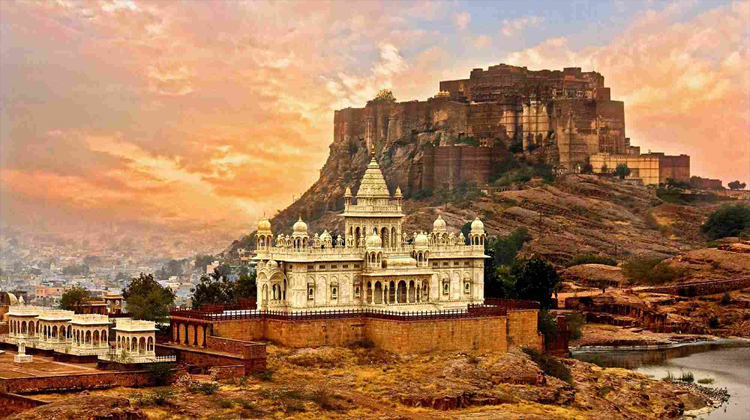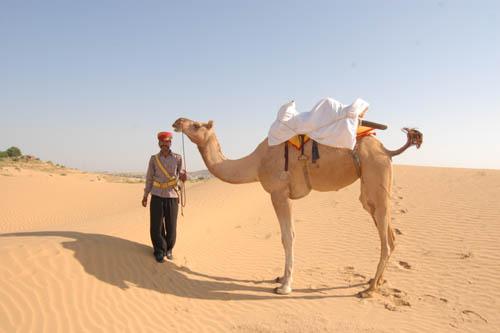Recogeremos desde el aeropuerto o la estación de tren y luego visitaremos Sun City
Estado de Jodhpur también conocido históricamente como el Reino de Marwar. Fue un estado principesco en la región de Marwar desde 1226 hasta 1949. Su capital era la ciudad de Jodhpur desde 1450.
Los gobernantes Rathore del estado principesco indio de Jodhpur eran de una antigua dinastía establecida en el siglo VIII. Sin embargo, las fortunas de la dinastía fueron hechas por Rao Jodha, el primero de los gobernantes de la dinastía Rathore en Jodhpur en 1459.
El reino fue anexionado por el Imperio mogol después de la muerte de Chandrasen Rathore. Permaneció bajo el control directo de Mughal hasta que Udai Singh se restauró al trono como un vasallo y se le dio el título de Raja. Durante finales del siglo XVII estuvo bajo el estricto control del emperador Aurangzeb, pero la casa gobernante de Rathore pudo permanecer semiautónoma en su territorio. Durante este tiempo, Durgadas Rathore luchó para preservar la dinastía rathore y liberó a Marwar del Imperio mogol después de 25 años de guerra. Los británicos no tuvieron ningún papel en los asuntos del estado hasta la década de 1830, cuando el Raja en ese momento, Man Singh, entró en una alianza subsidiaria, después de lo cual los Rajas de Marwar (o Jodhpur) continuaron como gobernantes de un estado principesco.
Lugares de Jodhpur
Fuerte Mehrangarh: –
Mehrangarh fort se encuentra en la ciudad de Jodhpur en el estado de Rajasthan de la India. Este gigantesco fuerte del siglo XV está situado en la colina rocosa, a 125 metros de altura del suelo y rodeado por un alto muro de diez kilómetros con ocho puertas e innumerables torres. Hay cuatro puertas conectadas a las carreteras invisibles y serpenteantes de este fuerte. Dentro del fuerte hay muchos palacios grandiosos, esculturas maravillosas, ventanas enrejadas y nombres inspiradores. Entre estos destacan el moti mahal, el palacio de las flores, el sheesh mahal, el sileh khan, el daulat khan, etc. Estos palacios contienen una asombrosa colección de muebles de cocina india. Aparte de esto, también hay una maravillosa colección de clientes, elefantes, pequeñas pinturas de diferentes estilos, instrumentos musicales, trajes y muebles.

Jaswant Thada :-
El Jaswant Thada es un cenotafio ubicado en Jodhpur, en el estado indio de Rajasthan. Fue construido por Maharaja Sardar Singh del estado de Jodhpur en 1899 en memoria de su padre, Maharaja Jaswant Singh II
Ghanta Ghar, también conocida como la torre del reloj de Rajasthan, se encuentra en la ciudad india de Jodhpur. Fue construido por Maharaja Sardar Singh Después de una visita completa a la ciudad, maneje hacia Osian y visite la aldea rural osian.
Osian es una antigua ciudad situada en el distrito de Jodhpur, en el estado de Rajasthan, al oeste de la India. Es un oasis en el desierto de Thar, y ha sido conocido como el “Khajuraho de Rajasthan” por sus templos. La ciudad es una aldea panchayat y la sede de Tehsil Osian. Se encuentra a 69 km por carretera al norte de la sede del distrito en Jodhpur,
Osian es una antigua ciudad situada a unos 65 km de Jodhpur. Es famoso por muchos hermosos templos que existieron durante siglos. Estos templos han sido bellamente construidos. Algunos de estos son templos jainistas y hay Sachiya Mata Mandir, Surya Mandir, Templo Harihar, Pipala Devi Mandir, Templo Shiv y Templo Vishnu. Los templos de Jain son del siglo VIII al XI. El Templo del Sol y el Templo Shivaliya son conocidos por su belleza.
La ciudad era un importante centro comercial al menos desde el período Gupta. Mantuvo este estado, mientras que también fue un importante centro de brahmanismo y jainismo durante cientos de años.
Y disfrutarás en el desierto de Osian. Y disfrutarás de un safari en camello en el desierto de osian luego de regresar a Jodhpur y pasar por el horario de salida
Servicios incluidos en el precio de mi recorrido: –
1. Un agradable y cómodo automóvil Air Condition Etios para que tenga espacio suficiente para su equipaje también, combustible, seguro, impuestos de peaje, todos los impuestos estatales, estacionamiento y todos los gastos relacionados con el transporte.
2. Coche estará con usted desde su llegada hasta su partida. Significa que le daré un coche para que lo recoja del aeropuerto o la estación de tren, traslado al hotel, para trasladar una ciudad a otra, para todas las ciudades que se visitan, muchas excursiones que están en camino y que aterrizan en el aeropuerto o la estación de ferrocarril.
3. Camel Safari en el desierto de Osian
Paquetes de viaje de Rajasthan
Turismo en Rajastán
Alquiler de autos en Rajasthan
